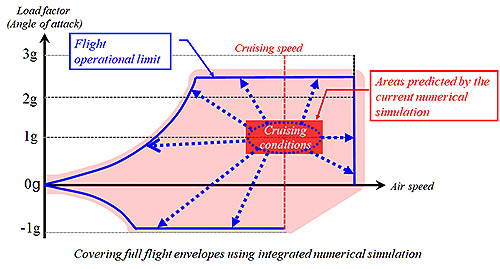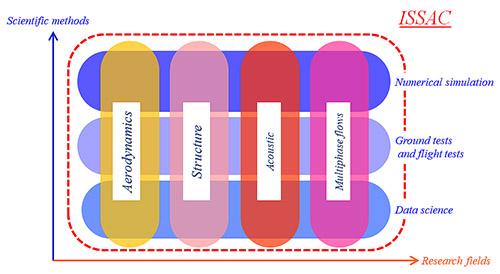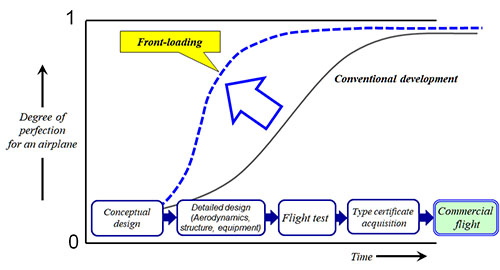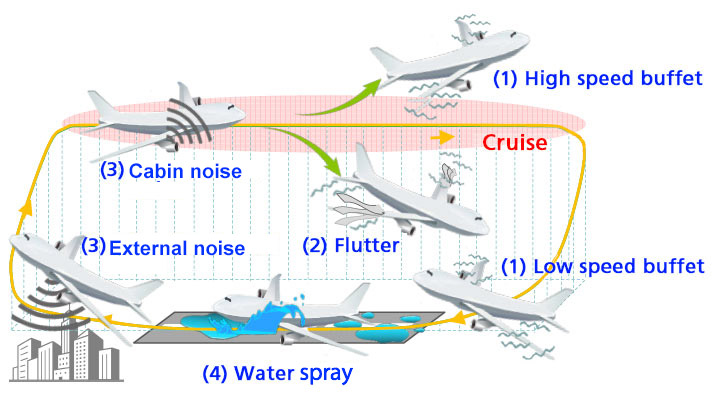Research & Development
JAXA promotes three research and development programs and a fundamental research program that underpins them.
Integrated simulation technologies
Numerical simulation that can predict aircraft characteristics on a computer plays a key role in the aircraft development process. However, the current numerical simulation technology has its prediction limits, and simulation results must be utilized within the confines of these limitations. New R&D approaches are necessary to enable simulation beyond current limitations.
JAXA is engaging in research and development of the “Integrated Simulation System of Aerospace vehiCles (ISSAC)” to extent numerical simulation coverage by combining expertise from multiple technical fields for aircraft development and aeronautical R&D.
Overall aim of ISSAC
The overall aim of ISSAC is to enable highly accurate and reliable numerical simulation for full-flight envelopes including off-design conditions.
The following chart shows the flight envelope, the region in which an aircraft can operate safely, defined in terms of airspeed and load factor (corresponding to the angle of attack). The aerodynamic lift of the 1g flight is equal to its own mass. When swiveling, more than 1g aerodynamic lift is generated to support centrifugal force. When descending, aerodynamic lift becomes smaller than its own mass, hence it is less than 1g flight.
The red circle in the center of the chart is the cruising conditions, which we can predicted rather accurately with current numerical simulation technologies. However, there are flight conditions other than cruising, which are called “off design (out of designed) conditions.” Aircraft must fly safely in these off-design conditions where many complicated and unsteady phenomena such as pressure fluctuations occur around an aircraft. It is difficult to predict such off-design conditions with current numerical simulation technologies. Instead, we conduct wind-tunnel tests using a scaled model and flight tests using actual aircraft repeatedly to improve the simulation accuracy. Such a process consumes time and money.
With ISSAC, we aim to develop an advanced numerical simulation system that can predict not only cruise conditions but all of the flight envelopes including unsteady and complicated phenomena occurring in the off-design conditions.

ISSAC's approach
The key to success for the development of ISSAC would be how to integrate various expertise accumulated in the aeronautical R&D field in JAXA. With the ISSAC, JAXA aims to attain a highly advanced numerical simulation using two types of technological integration. One is multidisciplinary integration across a wide variety of research fields in aeronautics, such as aerodynamics, structure, acoustics, multiphase flows, and flight, to overcome complex and multi-physics problems straddling across several fields. The other is the cyber-physical integration of different types of simulation methods, such as numerical simulation, wind-tunnel tests, flight tests, and data science, to complement the respective advantages and disadvantages of each simulation method.

Cyber-physical technology integration in ISSAC with multidisciplinary approach
What can be achieved by ISSAC
When ISSAC makes it possible for highly precise predictions for full flight envelopes including off-design conditions, we will be able to predict actual airplane characteristics with higher accuracy using only computer simulation at an early development stage where a scaled wind-tunnel model and flight tests are still not available. Through such a procedure, the degree of perfection can be enhanced for an airplane design faster and earlier, and we can reduce time and costs for detailed design and flight tests. This is a big advantage of “front-loading for airplane development.”
Over the next two decades, aircraft manufacturing market is forecasted to grow double in the size globally. ISSAC’s integrated simulation technology would make the whole aircraft development cycle more efficiently with increased development speed and reduced cost, which would help Japanese aviation industry to increase their presence on the global market and to strengthen international competitiveness.

Front-loading for airplane development by ISSAC
Technologies addressed by ISSAC
JAXA has set four priority targets for the development of ISSAC, together with three additional targets as criteria for extra success. These targets are selected based on several points of view, such as challenges that emerged through airplane development in the private sector, technologies that should be retained by JAXA as a public research organization, and for future research strategies.

Technologies addressed by ISSAC
[Priority targets]
- Prediction technology for low- and high-speed buffet
Estimating the conditions that generate unsteady aerodynamics, buffet phenomena, that cause airplane vibration under off-design flight conditions. - Prediction technology for flatter
Estimating the conditions that generate flatter which are destructive vibrations coupled with aerodynamics and structural phenomena. - Prediction technology for cabin noise and external noise
Estimating noise inside and outside of an airplane for improving quietness of passenger cabins and for reducing the environmental burden around airports. - Prediction technology for water spray
Estimating the impact of multiphase water spray on an airplane when water is spattered by tires running through puddles of water on a wet runway on a stormy day.
[Additional targets as criteria for extra success]
- Predicting steerage and dynamic stability
- Aerodynamic prediction of actual airplane scale
- Comparison and extraction technology by data science and modeling
March 31, 2020

